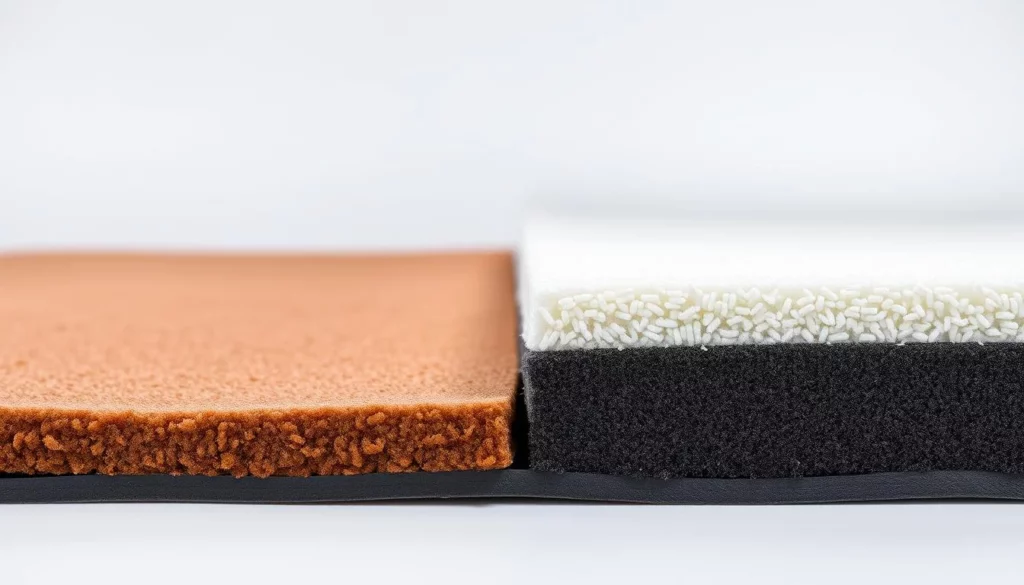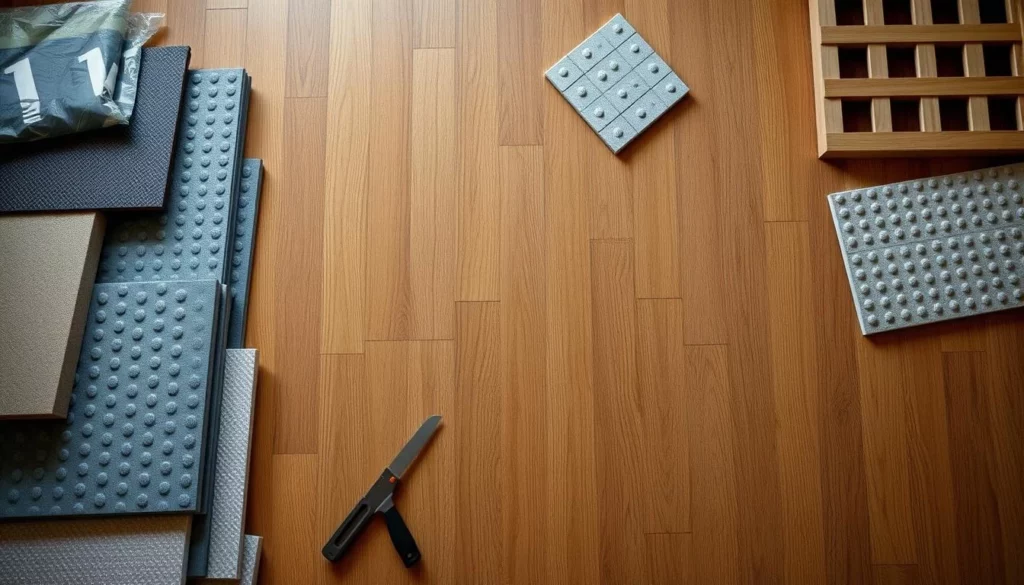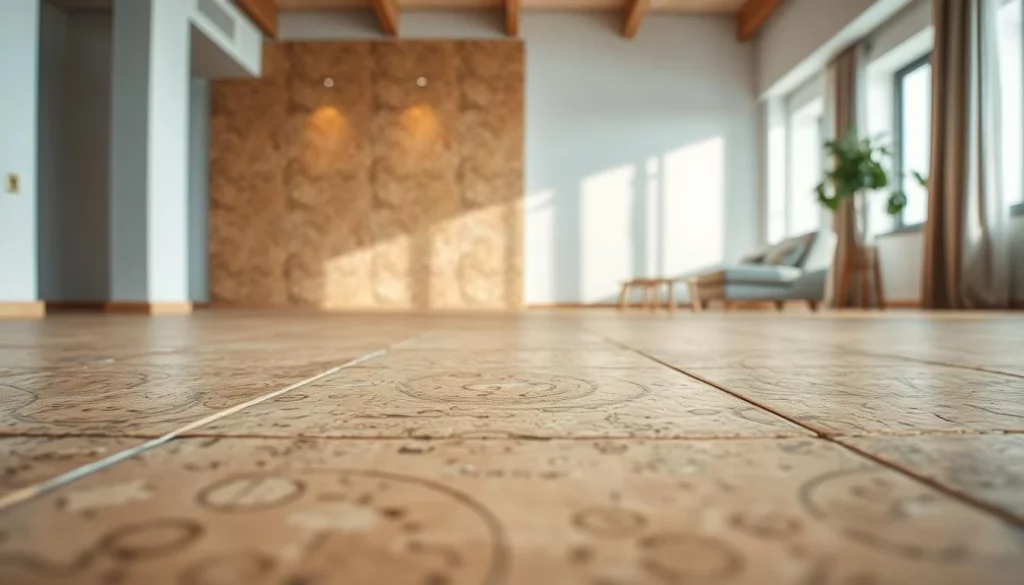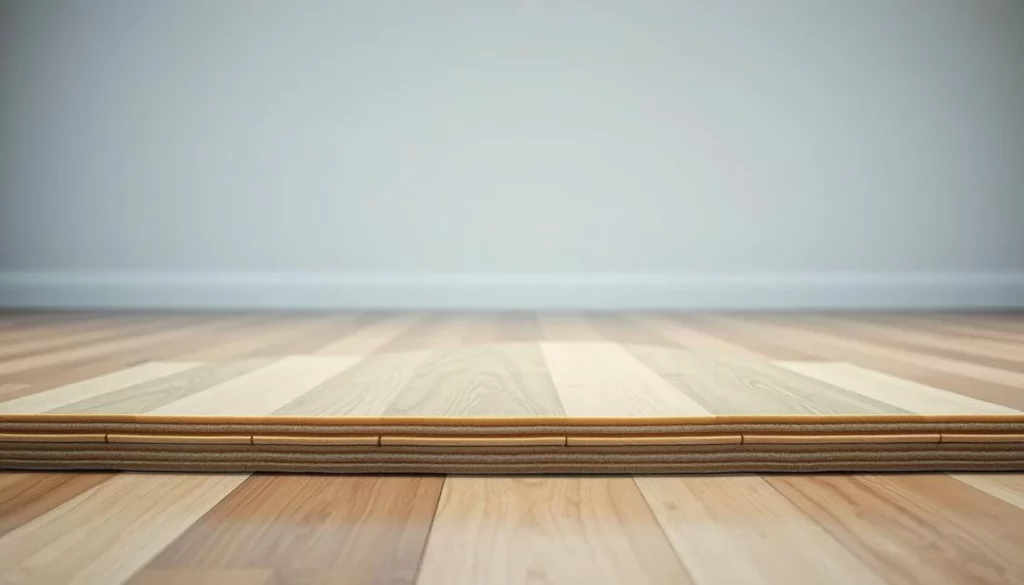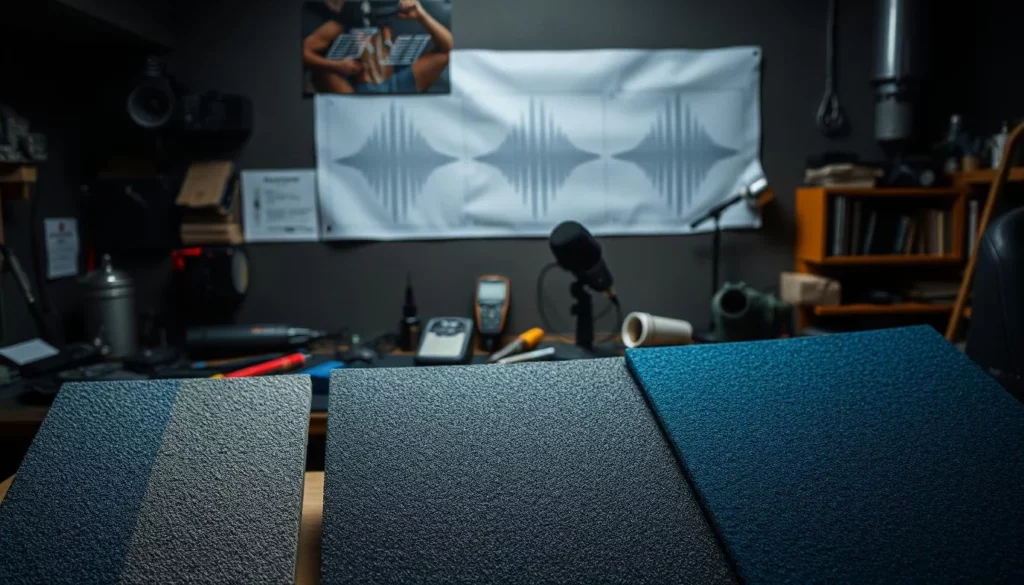Choosing the right underlayment for your flooring can be tough. There are many options out there. When deciding between rubber and foam underlays, it’s key to look at their pros and cons.
Industry experts say rubber underlayment is durable and effective. On the other hand, foam underlayment can compress over time. This makes it less effective.
When comparing rubber and foam underlays, think about durability, sound quality, and performance. Knowing the differences helps you choose the best underlay for your flooring needs.
Introduction to Underlays: What You Need to Know
Underlayment is key for any flooring job. It acts as a shield and support between the subfloor and the flooring. With many options out there, picking the right one can be tough. This section will cover the basics of underlayment and what to consider before you decide.
There are several underlayment materials, like foam, rubber, cork, and felt. Each has its own strengths and weaknesses. For example, foam is lightweight and easy to install. Rubber, on the other hand, is very durable and great for sound insulation.
When looking at underlay materials, think about soundproofing, moisture resistance, and flooring compatibility. For top-notch sound insulation, rubber is a good pick. If you’re on a tight budget and want something simple to install, foam might be better.
Here are some key things to think about when choosing an underlayment:
- The type of flooring you are installing
- The condition of your subfloor
- Your budget for the project
- The level of sound insulation required
- The need for moisture resistance
By knowing these factors and the various underlayment options, you can make a choice that fits your needs. This will improve your flooring’s performance.
Benefits of Rubber Underlays
Rubber underlays are great for both homeowners and builders. They last long and keep moisture out. This makes them perfect for any renovation or new building.
Rubber underlays are known for being long-lasting. They don’t break down like other materials do. So, your floors stay comfy and supported for many years.
Durability and Longevity
Rubber underlays are very durable. They can handle lots of foot traffic and daily wear. This makes them great for homes and businesses.
They also keep their sound-absorbing abilities over time. Your space will stay quiet, even when it’s busy.
| Feature | Rubber Underlay | Other Materials |
|---|---|---|
| Durability | High | Variable |
| Sound Insulation | Excellent | Good |
| Moisture Resistance | High | Low to Medium |
Sound Insulation Properties
Rubber underlays are also known for their sound insulation. They help keep noise from traveling between floors. This makes living or working spaces quieter and more peaceful.
This is really helpful in buildings or homes with multiple levels. Footsteps and other sounds can be a big problem.
Moisture Resistance
Rubber underlays are also moisture-resistant. This is great for places that get damp or wet, like basements or bathrooms.
They protect your floors from water damage. This keeps your indoor air clean and healthy.
In short, rubber underlays are a smart choice for many reasons. They last long, block sound, and resist moisture. This is why they’re becoming more popular with homeowners and builders.
Advantages of Foam Underlays
Foam underlayment is a favorite among homeowners for good reasons. It offers comfort, support, and insulation for different flooring types.
Lightweight and Easy to Handle
Foam underlays are light, making them simple to handle and install. This is great for DIY projects or big areas.
Enhanced Comfort Underfoot
Foam underlayment adds enhanced comfort underfoot. It’s perfect for homes with lots of foot traffic. The foam’s cushioning reduces fatigue and discomfort from hard floors.
Cost-Effectiveness
Foam underlayment is also cost-effective. It’s cheaper than other materials, which is good for those watching their budget.
| Feature | Foam Underlay | Rubber Underlay |
|---|---|---|
| Weight | Lightweight | Heavier |
| Comfort Level | High | High |
| Cost | Generally Affordable | More Expensive |
The table shows foam underlays are light and affordable. These benefits make them a top choice for many homeowners.
Comparing Insulation Properties of Rubber and Foam
Rubber and foam underlays have different insulation properties. These properties can greatly affect your flooring’s performance. The right underlay can improve your home’s comfort and energy use.
Insulation comes in two main types: thermal and acoustic. Knowing how rubber and foam underlays work in these areas is key. This knowledge helps you choose the best underlay for your needs.
Thermal Insulation
Keeping your home at a comfortable temperature is important. Rubber underlays have a high thermal mass. This helps keep the floor warm in winter and cool in summer.
Foam underlays are made to keep heat from transferring. They help make your home more energy-efficient.
| Underlay Type | Thermal Insulation Property | Benefit |
|---|---|---|
| Rubber | High thermal mass | Regulates floor temperature |
| Foam | Reduces heat transfer | Energy efficiency |
Acoustic Insulation
Acoustic insulation is also crucial, more so in multi-story buildings or homes with many people. Rubber underlays are great at absorbing sound. They reduce footfall noise and other sounds.
Foam underlays also dampen sound, but their effectiveness depends on the type and thickness of the foam.
| Underlay Type | Acoustic Insulation Property | Benefit |
|---|---|---|
| Rubber | Sound-absorbing | Reduces footfall noise |
| Foam | Sound dampening | Quieter environment |
By comparing rubber and foam underlays, you can pick the best for your insulation needs. This choice will make your home more comfortable and energy-efficient.
Installation Process for Rubber Underlays
Installing rubber underlayment is easy with the right tools and a bit of guidance. It’s important to prepare well and know the steps to take.
Tools and Materials Needed
First, collect all the tools and materials you need. You’ll need a rubber underlayment sheet, a utility knife or a special cutting tool, a measuring tape, adhesive (if needed), and a roller or similar tool for applying pressure.
- Rubber underlayment sheet
- Utility knife or cutting tool
- Measuring tape
- Adhesive (if necessary)
- Roller or pressure applicator
Step-by-Step Installation Guide
Here’s how to install your rubber underlayment:
- Measure the area where you plan to install the underlayment, taking into account any obstructions or irregularities.
- Cut the rubber underlayment to size using a utility knife or a specialized cutting tool, leaving a small margin for adjustments.
- If required, apply adhesive to the subfloor or the underside of the underlayment, following the manufacturer’s instructions.
- Carefully lay the underlayment, starting from one edge and working your way across to avoid air bubbles.
- Use a roller or a similar tool to apply even pressure, ensuring good contact between the underlayment and the subfloor.
The table below outlines the key steps and things to consider during installation:
| Step | Description | Considerations |
|---|---|---|
| 1. Measure the Area | Accurately measure the space | Account for obstructions |
| 2. Cut to Size | Cut the underlayment | Leave a margin for adjustments |
| 3. Apply Adhesive | Apply adhesive if necessary | Follow manufacturer’s instructions |
Installation Process for Foam Underlays
To install foam underlays smoothly, knowing the steps and materials is key. It’s a simple process that requires the right tools and some guidance.
Tools and Materials Needed
Before you start, gather these tools and materials:
- Foam underlayment rolls
- Utility knife or foam cutter
- Tape measure
- Pencil or marker
- Adhesive (if required)
- Tapping block
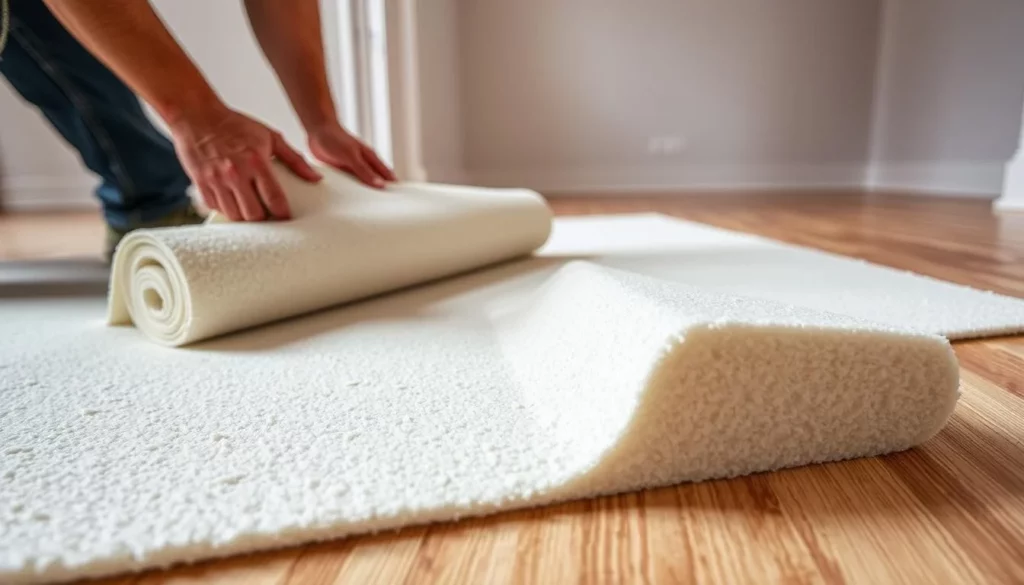
Step-by-Step Installation Guide
Here’s how to install your foam underlayment:
- Measure the Room: Measure the room’s length and width to figure out how much foam you need.
- Cut the Foam Underlayment: Cut the underlayment to size with a utility knife or foam cutter. Leave some extra around the edges.
- Lay the Underlayment: Start by placing the underlayment in a room corner. Work your way outwards. Make sure it’s aligned and smooth out wrinkles or air bubbles.
- Secure the Underlayment: If needed, use adhesive to stick the underlayment to the subfloor. Follow the manufacturer’s instructions.
- Trim Excess Material: After placing the underlayment, trim any extra around the edges with a utility knife.
By following these steps and using the right tools, you can install foam underlay successfully. This will enhance comfort and insulation for your flooring.
Cost Comparison: Rubber vs. Foam Underlays
Choosing between rubber and foam underlays means looking at the cost. Each has its own benefits and drawbacks that impact the price.
The cost of underlayment is a big part of the decision. Rubber underlays cost more at first than foam underlays. But, rubber lasts longer, making it a better value in the long run.
Initial Investment
Rubber underlays can cost between $0.50 and $2.00 per square foot. This depends on quality and thickness. Foam underlays, on the other hand, cost between $0.25 and $1.00 per square foot.
| Underlay Type | Cost per Square Foot |
|---|---|
| Rubber Underlay | $0.50 – $2.00 |
| Foam Underlay | $0.25 – $1.00 |
Long-Term Value
Foam underlays might be cheaper at first, but they don’t last as long as rubber. Rubber underlays can last up to 20 years with care. Foam underlays need to be replaced every 5 to 10 years.
Looking at the long-term, rubber underlays are more cost-effective. It’s important to think about replacement costs and lifespan when deciding.
Environmental Impact of Rubber and Foam Underlays
When picking an underlay for your floor, think about its environmental impact. Rubber and foam underlays each have their own environmental effects, from making to throwing away.
Rubber underlays, like those from recycled rubber, are a green choice. They use recycled materials, cutting down on waste and the need for new rubber. For more on recycled rubber underlays, check out Buildtec Acoustics.
Sustainability of Rubber Products
Rubber underlays last a long time, which makes them eco-friendly. They need to be replaced less often, which means less waste. Plus, many rubber underlays are made from recycled stuff, making them even greener.
Recycling Options for Foam
Foam underlays might not last as long as rubber, but they have their green points. Some foam products can be recycled, and some makers have programs to take back old foam. It’s important to look into these options when picking a foam underlay.
Looking at the environmental effects of rubber and foam underlays, we see both have good and bad sides. Your choice should depend on many factors, like how long it lasts, where it comes from, and how it’s recycled or thrown away.
Ideal Applications for Rubber Underlays
Rubber underlays are versatile and fit many uses. They are great in places where things need to last long and stay dry.
Best Environments for Use
Rubber underlays work best in busy or wet areas. They are perfect for:
- Commercial spaces with lots of people walking by
- Bathrooms and kitchens where water is common
- Gymnasiums and fitness centers
Compatibility with Flooring Types
Rubber underlays go well with many floors, such as:
| Flooring Type | Compatibility | Benefits |
|---|---|---|
| Hardwood Flooring | High | Reduces noise, provides insulation |
| Laminate Flooring | High | Enhances comfort, reduces impact noise |
| Tile Flooring | Moderate | Provides thermal insulation, reduces noise |
Rubber underlays bring many benefits. They are long-lasting, keep moisture out, and block sound. When picking an underlay, think about your space’s needs and the flooring you want.
Ideal Applications for Foam Underlays
Foam underlays are great for flooring because they’re comfy, easy to put in, and work well with many types of floors. They’re perfect for home makeovers or new floors in offices. Foam underlays bring lots of benefits that make them a top pick.
Best Environments for Use
Foam underlays fit well in many places, like homes, offices, and shops. They’re best in spots where you want to feel comfy and quiet, like bedrooms and living rooms. For more info on foam vs. rubber underlays, check out this link.
- Residential Homes: Foam underlays make floors softer and quieter, perfect for homes with many floors.
- Commercial Spaces: Foam underlays can make offices and shops quieter, improving the feel of the space.
- High-Traffic Areas: Foam underlays are good for places with a lot of people, but for really busy spots, choose a denser foam.
Compatibility with Flooring Types
Foam underlays work well with many floors, like laminate, engineered wood, and luxury vinyl tiles (LVT). They create a smooth surface that can make floors last longer.
- Laminate Flooring: Foam underlays add comfort and cut down on noise with laminate floors.
- Engineered Wood Flooring: They help keep the floor stable and can stop it from creaking.
- Luxury Vinyl Tiles (LVT): Foam underlays make LVT floors more comfy and warm underfoot.
Knowing when to use foam underlays can help you choose the best option for your floors. They’re versatile, comfy, and easy to install, making them a favorite for many flooring projects.
Conclusion: Choosing the Right Underlay for Your Space
When picking between rubber and foam underlays, think about what you need for your floor. Rubber underlays are tough and keep moisture out, great for busy spots and damp places. Foam underlays, on the other hand, make your floor feel softer and are easier on your wallet, perfect for homes.
Think about your floor type, how much it gets used, and how comfy you want it to be. This will help you pick the best underlay for your space. Whether you want something strong, soft, or budget-friendly, the right underlay makes a big difference.
